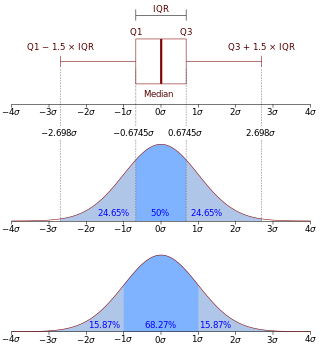逆威沙特分布| 母數 |
 自由度 (實數) 自由度 (實數)
 尺度矩陣 (正定) 尺度矩陣 (正定) |
|---|
| 值域 |
 是正定的 是正定的 |
|---|
| 機率密度函數 |
 |
|---|
| 期望值 |
 |
|---|
| 眾數 |
 [1]:406 [1]:406 |
|---|
逆威沙特分布,也叫反威沙特分布作是統計學中出現的一類機率分布函數,定義在實值的正定矩陣上。在貝氏統計中,逆威沙特分布會用作多變量常態分布共變異數矩陣的共軛先驗分布。
如果一個正定矩陣  的逆矩陣
的逆矩陣  遵從威沙特分布
遵從威沙特分布  的話,那麼就說矩陣
的話,那麼就說矩陣  遵從逆威沙特分布:
遵從逆威沙特分布:

逆威沙特分布的機率密度函數是:

其中  和
和  都是
都是  的正定矩陣,而Γp(·) 則是多變量伽馬分布。函數
的正定矩陣,而Γp(·) 則是多變量伽馬分布。函數

指的是跡函數。
設矩陣 並且
並且  是
是 的矩陣,那麼
的矩陣,那麼  遵從逆威沙特分布:
遵從逆威沙特分布: 。它的機率密度函數是:
。它的機率密度函數是:

其中  ,而
,而  是多變量伽馬分布[2]。
是多變量伽馬分布[2]。
設矩陣  遵從逆威沙特分布。並且假設矩陣
遵從逆威沙特分布。並且假設矩陣  和
和  都有相適合的分塊矩陣表示方式:
都有相適合的分塊矩陣表示方式:

其中子矩陣  和
和  是
是  的矩陣,那麼會有:
的矩陣,那麼會有:
甲) 和
和  與
與  相互獨立,其中
相互獨立,其中  是子矩陣
是子矩陣  在
在  中的舒爾補。
中的舒爾補。
乙)  ;
;
丙)  ,其中
,其中  是矩陣常態分布。
是矩陣常態分布。
丁)
假設要求事前分布  為逆威沙特分布
為逆威沙特分布  的共變異數矩陣
的共變異數矩陣 。如果觀測值
。如果觀測值
![{\displaystyle \mathbf {X} =[\mathbf {x} _{1},\ldots ,\mathbf {x} _{n}]}](https://wikimedia.org/api/rest_v1/media/math/render/svg/75115177c99d2884ec80cdacf66d2cf69caed817) 是從互相獨立的 p-變量常態分布
是從互相獨立的 p-變量常態分布  的隨機變數得到的,那麼條件分布
的隨機變數得到的,那麼條件分布
 遵從的是逆威沙特分布:
遵從的是逆威沙特分布: 。其中
。其中  是樣本共變異數矩陣的
是樣本共變異數矩陣的 倍。
倍。
因此,逆威沙特矩陣是多變量常態分布的共軛事前分布。
期望值:[2]:85

矩陣  的每一個係數的變異數:
的每一個係數的變異數:

對角係數的變異數是在上式中令  得到,化簡後變成:
得到,化簡後變成:

當變量數目減到一個的時候,逆威沙特分布會變成特例:逆伽馬分布。也就是說,當  、
、 、
、 以及
以及  的時候,逆威沙特分布的機率密度函數是:
的時候,逆威沙特分布的機率密度函數是:

這正是逆伽馬分布。其中  是通常的伽馬函數。
是通常的伽馬函數。
而逆威沙特分布也有推廣,其中一個是常態逆威沙特分布。






































![{\displaystyle \mathbf {X} =[\mathbf {x} _{1},\ldots ,\mathbf {x} _{n}]}](https://wikimedia.org/api/rest_v1/media/math/render/svg/75115177c99d2884ec80cdacf66d2cf69caed817)

















